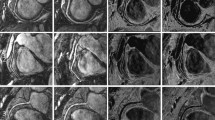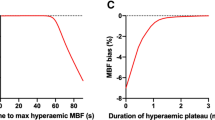Abstract
This study was aimed to investigate the use of 1.5-T whole-heart 3D coronary MRA employing a T2-prepared SSFP sequence for assessing epicardial coronary artery vasodilation following exogenous nitrates. Navigator-gated whole-heart 3D coronary MRA was performed before and after sublingual nitroglycerin (NTG) in 22 volunteers and a T2-prepared SSFP sequence was used for imaging of coronary arteries without MR contrast agent. Coronary cross-sectional area was measured on pre- and post-NTG images of equivalent coronary segments in the major coronary arteries and whole-heart coronary vasodilation was analyzed quantitatively. Measurements were obtained by two independent investigators. Coronary vasodilation could be observed directly on multiplanar reformatted and three-dimensional volume-rendered MR images. On quantitative analysis, NTG administration results in the whole-heart coronary vasodilation by an average of 37.3 ± 12.7%. There was moderate yet significant correlation between the NTG-induced vasodilation and age (r = −0.52, P = 0.02). The mean absolute cross-sectional area of the coronary arteries was significantly higher after sublingual NTG in all the major coronary arteries. The coronary area measurements had an interobserver variability of 8 ± 3% and an intraoberver variability of 4 ± 2%. Non-contrast-enhanced 1.5-T SSFP whole-heart coronary MRA can noninvasively measure endothelium-independent coronary vasodilation over the entire heart with high feasibility and is a promising noninvasive method to explore whole-heart coronary smooth muscle cell function following exogenous nitrates in clinical practice.




Similar content being viewed by others
References
Schindler TH, Hornig B, Buser PT, Olschewski M, Magosaki N, Pfisterer M, Nitzsche EU, Solzbach U, Just H (2003) Prognostic value of abnormal vasoreactivity of epicardial coronary arteries to sympathetic stimulation in patients with normal coronary angiograms. Arterioscler Thromb Vasc Biol 23(3):495–501
Vita JA, Treasure CB, Nabel EG, McLenachan JM, Fish RD, Yeung AC, Vekshtein VI, Selwyn AP, Ganz P (1990) Coronary vasomotor response to acetylcholine relates to risk factors for coronary artery disease. Circulation 81(2):491–497
Bonetti PO, Lerman LO, Lerman A (2003) Endothelial dysfunction: a marker of atherosclerotic risk. Arterioscler Thromb Vasc Biol 23(2):168–175
Schachinger V, Britten MB, Zeiher AM (2000) Prognostic impact of coronary vasodilator dysfunction on adverse long-term outcome of coronary heart disease. Circulation 101(16):1899–1906
Quyyumi AA (2003) Prognostic value of endothelial function. Am j cardiolog 91(12A):19H–24H
Hays AG, Hirsch GA, Kelle S, Gerstenblith G, Weiss RG, Stuber M (2010) Noninvasive visualization of coronary artery endothelial function in healthy subjects and in patients with coronary artery disease. J Am Coll Cardiol 56(20):1657–1665
Suwaidi JA, Hamasaki S, Higano ST, Nishimura RA, Holmes DR Jr, Lerman A (2000) Long-term follow-up of patients with mild coronary artery disease and endothelial dysfunction. Circulation 101(9):948–954
von Mering GO, Arant CB, Wessel TR, McGorray SP, Bairey Merz CN, Sharaf BL, Smith KM, Olson MB, Johnson BD, Sopko G, Handberg E, Pepine CJ, Kerensky RA (2004) Abnormal coronary vasomotion as a prognostic indicator of cardiovascular events in women: results from the National Heart, Lung, and Blood Institute-Sponsored Women’s Ischemia Syndrome Evaluation (WISE). Circulation 109(6):722–725
Vavuranakis M, Stefanadis C, Triandaphyllidi E, Toutouzas K, Toutouzas P (1999) Coronary artery distensibility in diabetic patients with simultaneous measurements of luminal area and intracoronary pressure: evidence of impaired reactivity to nitroglycerin. J Am Coll Cardiol 34(4):1075–1081
Terashima M, Nguyen PK, Rubin GD, Iribarren C, Courtney BK, Go AS, Fortmann SP, McConnell MV (2008) Impaired coronary vasodilation by magnetic resonance angiography is associated with advanced coronary artery calcification. JACC Cardiovasc Imaging 1(2):167–173
Hollenberg SM, Tamburro P, Johnson MR, Burns DE, Spokas D, Costanzo MR, Parrillo JE, Klein LW (1999) Simultaneous intracoronary ultrasound and Doppler flow studies distinguish flow-mediated from receptor-mediated endothelial responses. Catheter Cardiovasc Interv 46(3):282–288
Hundley WG, Bluemke DA, Finn JP, Flamm SD, Fogel MA, Friedrich MG, Ho VB, Jerosch-Herold M, Kramer CM, Manning WJ, Patel M, Pohost GM, Stillman AE, White RD, Woodard PK (2010) ACCF/ACR/AHA/NASCI/SCMR 2010 expert consensus document on cardiovascular magnetic resonance: a report of the American College of Cardiology Foundation Task Force on Expert Consensus Documents. Circulation 121(22):2462–2508
Nguyen PK, Meyer C, Engvall J, Yang P, McConnell MV (2008) Noninvasive assessment of coronary vasodilation using cardiovascular magnetic resonance in patients at high risk for coronary artery disease. J Cardiovasc Magn Reson 10(1):28
Terashima M, Meyer CH, Keeffe BG, Putz EJ, de la Pena-Almaguer E, Yang PC, Hu BS, Nishimura DG, McConnell MV (2005) Noninvasive assessment of coronary vasodilation using magnetic resonance angiography. J Am Coll Cardiol 45(1):104–110
Pepe A, Lombardi M, Takacs I, Positano V, Panzarella G, Picano E (2004) Nitrate-induced coronary vasodilation by stress-magnetic resonance imaging: a novel noninvasive test of coronary vasomotion. J Magn Reson Imaging 20(3):390–394
Deshpande VS, Shea SM, Laub G, Simonetti OP, Finn JP, Li D (2001) 3D magnetization-prepared true-FISP: a new technique for imaging coronary arteries. Magn Reson Med 46(3):494–502
Weber OM, Martin AJ, Higgins CB (2003) Whole-heart steady-state free precession coronary artery magnetic resonance angiography. Magn Reson Med 50(6):1223–1228
Sakuma H, Ichikawa Y, Suzawa N, Hirano T, Makino K, Koyama N, Van Cauteren M, Takeda K (2005) Assessment of coronary arteries with total study time of less than 30 minutes by using whole-heart coronary MR angiography. Radiology 237(1):316–321
Kato S, Kitagawa K, Ishida N, Ishida M, Nagata M, Ichikawa Y, Katahira K, Matsumoto Y, Seo K, Ochiai R, Kobayashi Y, Sakuma H (2010) Assessment of coronary artery disease using magnetic resonance coronary angiography: a national multicenter trial. J Am Coll Cardiol 56(12):983–991
Finn JP, Nael K, Deshpande V, Ratib O, Laub G (2006) Cardiac MR imaging: state of the technology. Radiology 241(2):338–354
Brown BG, Bolson E, Petersen RB, Pierce CD, Dodge HT (1981) The mechanisms of nitroglycerin action: stenosis vasodilatation as a major component of the drug response. Circulation 64(6):1089–1097
Goldstein RE, Stinson EB, Scherer JL, Seningen RP, Grehl TM, Epstein SE (1974) Intraoperative coronary collateral function in patients with coronary occlusive disease nitroglycerin responsiveness and angiographic correlations. Circulation 49(2):298–308
Harrison DG, Bates JN (1993) The nitrovasodilators new ideas about old drugs. Circulation 87(5):1461–1467
Duncker DJ, Bache RJ (2008) Regulation of coronary blood flow during exercise. Physiol Rev 88(3):1009–1086
Miller JM, Rochitte CE, Dewey M, Arbab-Zadeh A, Niinuma H, Gottlieb I, Paul N, Clouse ME, Shapiro EP, Hoe J, Lardo AC, Bush DE, de Roos A, Cox C, Brinker J, Lima JA (2008) Diagnostic performance of coronary angiography by 64-row CT. N Engl J Med 359(22):2324–2336
Shea SM, Deshpande VS, Chung YC, Li D (2002) Three-dimensional true-FISP imaging of the coronary arteries: improved contrast with T2-preparation. J Magn Reson Imaging 15(5):597–602
Maintz D, Aepfelbacher FC, Kissinger KV, Botnar RM, Danias PG, Heindel W, Manning WJ, Stuber M (2004) Coronary MR angiography: comparison of quantitative and qualitative data from four techniques. Am J Roentgenol 182(2):515–521
Jin H, Zeng MS, Ge MY, Yang S, Chen CZ, Shen JZ, Li RC (2009) A study of in vitro and in vivo MR of free-breathing whole-heart 3D coronary angiography using parallel imaging. Int J Card Imaging 25(1 Suppl):121–129
Niendorf T, Hardy CJ, Giaquinto RO, Gross P, Cline HE, Zhu Y, Kenwood G, Cohen S, Grant AK, Joshi S, Rofsky NM, Sodickson DK (2006) Toward single breath-hold whole-heart coverage coronary MRA using highly accelerated parallel imaging with a 32-channel MR system. Magn Reson Med 56(1):167–176
Pinto FJ, St Goar FG, Fischell TA, Stadius ML, Valantine HA, Alderman EL, Popp RL (1992) Nitroglycerin-induced coronary vasodilation in cardiac transplant recipients. evaluation with in vivo intracoronary ultrasound. Circulation 85(1):69–77
Okumura K, Yasue H, Matsuyama K, Ogawa H, Kugiyama K, Ishizaka H, Sumida H, Fujii H, Matsunaga T, Tsunoda R (1996) Diffuse disorder of coronary artery vasomotility in patients with coronary spastic angina hyperreactivity to the constrictor effects of acetylcholine and the dilator effects of nitroglycerin. J Am Coll Cardiol 27(1):45–52
Jost S, Rafflenbeul W, Reil GH, Trappe HJ, Gulba D, Hecker H, Gerhardt U, Knop I (1990) Elimination of variable vasomotor tone in studies with repeated quantitative coronary angiography. Int J Card Imaging 5(2–3):125–134
Jost S, Nolte CW, Sturm M, Hausleiter J, Hausmann D (1998) How to standardize vasomotor tone in serial studies based on quantitation of coronary dimensions? Int J Card Imaging 14(6):357–372
Jin H, Zeng MS, Ge MY, Ma JY, Chen CZ, Shen JZ, Li RC (2010) Influence of applying nitroglycerin in whole-heart free-breathing 3D coronary MR angiography. Ajr 194(4):927–932
Acknowledgments
This work was supported by the Zhongshan Science Foundation for young scholars (Grant number 393 to H.J).
Conflict of interest
None.
Author information
Authors and Affiliations
Corresponding author
Rights and permissions
About this article
Cite this article
Jin, H., Zeng, MS., Yun, H. et al. Noninvasive test of nitrate-induced coronary vasomotion by 1.5-T whole-heart 3D magnetic resonance angiography using a T2-prepared SSFP sequence. Int J Cardiovasc Imaging 28, 1707–1716 (2012). https://doi.org/10.1007/s10554-011-9999-7
Received:
Accepted:
Published:
Issue Date:
DOI: https://doi.org/10.1007/s10554-011-9999-7




